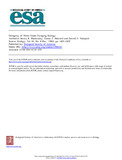Ontogeny Of Water Snake Foraging Ecology

View/
Date
1982Author
Mushinsky, Henry R.
Hebrard, James J.
Vodopich, Darrell S.
Language
enMetadata
Show full item recordAbstract
Using an index of relative importance we analyzed the stomach contents of over 300
water snakes (Nerodia spp.). Ontogenetic changes in prey consumption are most striking in Nerodia
erythrogaster (number with food in gut = 44) and N. fasciata (N = 72). Prey of these two species
changes from fish to frogs as the snakes exceed a snout-vent length of 50 cm. Nerodia rhombifera
(N = 159) and N. cyclopion (N = 65) primarily eat fish throughout their life. However, with maturity
and increased body size both species change portions of their diets. Nerodia rhombifera preys upon
larger fish which occupy deeper, open-water habitats, when the snakes exceed 80 cm. Nerodia cyclopion
eats a larger proportion of centrarchid fish as its body size increases. Small prey are found
in the stomachs of most size-classes of all four snake species. Regression analysis indicates that all
four species eat larger prey as they mature. However, the largest individuals are females, and in two
of the four species the large females eat a different array of prey than smaller nonspecific males. The
size sexual dimorphism does not reduce the overlap in the diets of the two species that eat anurans
as adults.
Citation
Mushinsky, Henry R., James J. Hebrard, and Darrell S. Vodopich. "Ontogeny of water snake foraging ecology." Ecology (1982): 1624-1629.Publisher
University of Nairobi,
